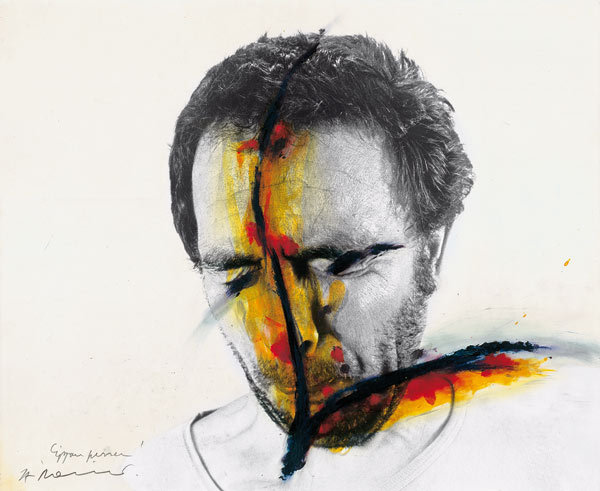Point of intersection Linz
dal 29/5/2009 al 8/8/2009
Segnalato da
29/5/2009
Point of intersection Linz
Lentos Art Museum, Linz
Young art and masterpicies. The exhibition explores the significance of Linz as a place where art is created and collected. The guest curators Dieter Buchhart and Johanna Schwanberg not only take a look at the regional art scene, but also virtually challenge the work from this scene with well known works from classical modernism all the way to contemporary art. In a diversity of media, fascinating connections unfold in eight thematic areas, such as the portrait, abstraction, landscape and science.

The exhibition Point of Intersection explores the significance of Linz as a place where art is created and collected. In the surroundings of the Art University and Ars Electronica, Linz is not only a fascinating place for art productions, but also cultivates a vibrant practice of collecting modern and contemporary art. This is reflected in both the international orientation of the Lentos Collection and in the city purchases of contemporary art affiliated with Linz.
In Point of Intersection, the guest curators Dieter Buchhart and Johanna Schwanberg not only take a look at the regional art scene, but also virtually challenge the work from this scene with well known works from classical modernism all the way to contemporary art. In this way, the presentation is woven into a cultural history journey between the eras and between the various artistic media, which characterize both a new presentation of the Lentos Collection and a presentation of exciting young and younger artists affiliated with Linz.
At the same time, the curators raise questions illuminating the parallels and divergences between works from different eras. What links a landscape painting by Caspar David Friedrich (1774-1840) with a nature photograph by Mathias Kessler (b. 1968), and how does the video that "gets under your skin" by the Linz Art University graduate Karin Fisslthaler (b. 1981) stand up to Egon Schiele's (1890-1918) radical, painterly self-scrutinizing?
The confrontations result in cross-connections and new perspectives: for instance, a profound engagement with human existence is just as inherent to the portraits by Oskar Kokoschka or Maria Lassnig as to those by Irma Kapeller or Herwig Kempinger. Landscape serves not only Caspar David Friedrich and Max Klinger, but also young, contemporary artists such as Mathias Kessler or Julie Monaco as a window to the understanding of nature in their time, thus forming a mirror of the respective society both in the 19th and in the 21st century.
In a diversity of media, fascinating connections unfold in eight thematic areas, such as the portrait, abstraction, landscape and science. There is a special focus on works dealing with socially relevant issues (migration, identity, social issues, globalization, gender issues) and on intermedia, artistic approaches (art and science, text and image, painting and sculpture).
Participating Artits:
Marc Adrian, Hiromi Akiyama, Franz Josef Altenburg, Josef Bauer, Gerlinde Beck, Sabine Bitter, Tina Blau, Markus Bless, Karl Blossfeldt, Miklos Boros, Dietmar Brehm, Günter Brus, Julia Margaret Cameron, Lovis Corinth, Róza El-Hassan, Manfred Erjautz, Lorenz Estermann, Tanja Estermann, VALIE EXPORT, Anselm Feuerbach, Karin Fisslthaler, Leopold ForstnerFriedrich Caspar David, Jakob Gasteiger, Harald Gsaller, Franz Graf, George Grosz, Helmuth Gsöllpointner, Heinrich Heidersberger, Candida Höfer, Bernadette Huber, Markus Huemer, Hildegard Joos, Donald Judd, Gudrun Kampl, Irma Kapeller, Björn Kämmerer, Herwig Kempinger, Mathias Kessler, Gustav Klimt, Max Klinger, Karl-Heinz Klopf, Matthias Klos, Gerhard Knogler, Clemens Kogler, Peter Kogler, Oskar Kokoschka, Jiri Kolár, Silvia Koller, Tamás Körösényi, Elke Krystufek, Maria Lassnig, Paul Albert Leitner, Erich Lessing, Max Liebermann, Hubert Lobnig, André Masson, Gerlinde Miesenböck, Paula Modersohn-Becker, Julie Monaco, Carl Moll, Andrew Molles, Inge Morath, Otto Mueller, Gabriele Münter, Ernst Wilhelm Nay, Shirin Neshat, Bernd Oppl, Hermann Josef Painitz, Uta Peyrer, Monika Pichler, Arnulf Rainer, Man Ray, Alexander Rodtschenko, Egon Schiele, Michèle Schnabel, Werner Schrödl, Hermann Staudinger, Emil Schumacher, Pascal Sébah, Franz Sedlacek, Günther Selichar, Richard Serra , Andrea van der Straeten, Hans Thoma, Simon Wachsmuth, Helmut Weber, Franziska und Lois Weinberger, Marianne von Werefkin, Charlotte Wiesmann, Manfred Wolff-Plottegg, Otto Zitko.
Dr. Johanna Schwanberg (born in 1966 in Vienna) Art and literature critic, curator, university lecturer.
Since 1996 Assistant Professor for Art Studies and Aesthetics at the Institute of Art Studies and Philosophy of the Catholic Theological Private University (KTU) Linz, and art and literature critic for "Parnass", for the feature section "spectrum" in the daily newspaper "Die Presse", for the feature section of the weekly newspaper "Die Furche", and others. Since 1998 curatorial and/or academic collaboration on exhibitions throughout Austria and abroad. Since 2004 she has contributed to the radio program "Thoughts for the Day."
Dr. Dieter Buchhart (born in Vienna in 1971) Curator, art theorist and artist, Director of the Kunsthalle Krems.
1990 - 2000 studied biology and art history. Curator of numerous exhibitions in renowned institutions in Austria and abroad. Since 1999 numerous monographs and interviews as editor of Kunstforum International. Author of numerous catalogue and journal essays as art theorist. Practicing artist since 2000 with solo exhibitions in Austria and abroad. Director of the Kunsthalle Krems since 2007.
Image: Arnulf Rainer
The exhibition is supported by Volksbank Linz+Mühlviertel.
Press Contact
Mag. Nina Kirsch, Tel. +43(0)732/7070-3603; nina.kirsch@lentos.at
Lentos Art Museum
Ernst-Koref-Promenade 1 - Linz
Opening Hours
daily 10 am - 6 pm; Thursday 10 am - 9 pm
Admission
€ 6,50, reduced € 4,50



